Embedment of Biosynthesised Silver Nanoparticles in PolyNIPAAm/Chitosan Hydrogel for Development of Proactive Smart Textiles
Abstract
1. Introduction
2. Materials and Methods
2.1. Materials
2.2. Synthesis of the Poly-NiPAAm/Chitosan (PNCS) Hydrogel
2.3. Preparation of Sumac Leaves’ Extract
2.4. Functionalisation of Viscose Fabric
2.5. Analysis and Measurements
2.5.1. Field Emission Scanning Electron Microscopy (FE-SEM) and Energy-Dispersive Field Emission Scanning Electron Microscopy (EDS)
2.5.2. Inductively Coupled Plasma-Mass Spectroscopy (ICP-MS)
2.5.3. Fourier Transform Infrared (FT-IR) Spectroscopy
2.5.4. Colour Measurements
2.5.5. Moisture Content
2.5.6. Water Uptake
2.5.7. Antibacterial Activity
2.5.8. UV-Protective Properties
3. Results and Discussion
3.1. Morphological and Chemical Properties of the Modified Viscose Samples
3.2. Assessment of Colour Change
3.3. Functional Properties
3.3.1. Temperature and pH Responsiveness of the Functionalised PNCS Hydrogel
3.3.2. Antibacterial Activity and Stimuli-Controlled Release of Biosynthesised Ag
3.3.3. UV Protection Activity
4. Conclusions
Author Contributions
Funding
Data Availability Statement
Acknowledgments
Conflicts of Interest
References
- Goyal, S.; Khot, S.C.; Ramachandran, V.; Shah, K.P.; Musher, D.M. Bacterial Contamination of Medical Providers’ White Coats and Surgical Scrubs: A Systematic Review. Am. J. Infect. Control 2019, 47, 994–1001. [Google Scholar] [CrossRef]
- Gupta, P.; Bairagi, N.; Gupta, D. Effect of Domestic Laundering on Removal of Bacterial Contamination from Nurses’ White Coats. In Functional Textiles and Clothing; Majumdar, A., Gupta, D., Gupta, S., Eds.; Springer: Singapore, 2019; pp. 67–73. [Google Scholar] [CrossRef]
- Dixit, S.; Varshney, S.; Gupta, D.; Sharma, S. Factors Affecting Biofilm Formation by Bacteria on Fabrics. Int. Microbiol. 2024, 27, 1111–1123. [Google Scholar] [CrossRef] [PubMed]
- Windler, L.; Height, M.; Nowack, B. Comparative Evaluation of Antimicrobials for Textile Applications. Environ. Int. 2013, 53, 62–73. [Google Scholar] [CrossRef] [PubMed]
- Morais, D.S.; Guedes, R.M.; Lopes, M.A. Antimicrobial Approaches for Textiles: From Research to Market. Materials 2016, 9, 498. [Google Scholar] [CrossRef]
- Simončič, B.; Tomšič, B. Recent Concepts of Antimicrobial Textile Finishes. In Textile Finishing: Recent Developments and Future Trends; Mittal, K.L., Bahners, T., Eds.; Scrivener Publishing: Beverly, MA, USA, 2017; pp. 1–68. [Google Scholar] [CrossRef]
- Rai, M.; Yadav, A.; Gade, A. Silver Nanoparticles as a New Generation of Antimicrobials. Biotechnol. Adv. 2009, 27, 76–83. [Google Scholar] [CrossRef] [PubMed]
- Radetić, M. Functionalization of Textile Materials with Silver Nanoparticles. J. Mater. Sci. 2013, 48, 95–107. [Google Scholar] [CrossRef]
- Simončič, B.; Klemenčič, D. Preparation and Performance of Silver as an Antimicrobial Agent for Textiles: A Review. Text Res. J. 2016, 86, 210–223. [Google Scholar] [CrossRef]
- Yetisen, A.K.; Qu, H.; Manbachi, A.; Butt, H.; Dokmeci, M.R.; Hinestroza, J.P.; Skorobogatiy, M.; Khademhosseini, A.; Yun, S.H. Nanotechnology in Textiles. ACS Nano 2016, 10, 3042–3068. [Google Scholar] [CrossRef] [PubMed]
- Durán, N.; Durán, M.; de Jesus, M.B.; Seabra, A.B.; Fávaro, W.J.; Nakazato, G. Silver Nanoparticles: A New View on Mechanistic Aspects on Antimicrobial Activity. Nanomed. Nanotechnol. Biol. Med. 2016, 12, 789–799. [Google Scholar] [CrossRef]
- Liao, C.; Li, Y.; Tjong, S.C. Bactericidal and Cytotoxic Properties of Silver Nanoparticles. Int. J. Mol. Sci. 2019, 20, 449. [Google Scholar] [CrossRef] [PubMed]
- Kalantari, K.; Mostafavi, E.; Afifi, A.M.; Izadiyan, Z.; Jahangirian, H.; Rafiee-Moghaddam, R.; Webster, T.J. Wound Dressings Functionalized with Silver Nanoparticles: Promises and Pitfalls. Nanoscale 2020, 12, 2268–2291. [Google Scholar] [CrossRef] [PubMed]
- Correa, M.G.; Martínez, F.B.; Vidal, C.P.; Streitt, C.; Escrig, J.; Lopez de Dicastillo, C. Antimicrobial Metal-Based Nanoparticles: A Review on Their Synthesis, Types, and Antimicrobial Action. Beilstein J. Nanotechnol. 2020, 11, 1450–1469. [Google Scholar] [CrossRef] [PubMed]
- Dakal, T.C.; Kumar, A.; Majumdar, R.S.; Yadav, V. Mechanistic Basis of Antimicrobial Actions of Silver Nanoparticles. Front. Microbiol. 2016, 7, 1831. [Google Scholar] [CrossRef] [PubMed]
- Choi, O.; Yu, C.P.; Fernández, G.E.; Hu, Z. Interactions of Nanosilver with Escherichia coli Cells in Planktonic and Biofilm Cultures. Water Res. 2010, 44, 6095–6103. [Google Scholar] [CrossRef] [PubMed]
- Wakshlak, R.B.K.; Pedahzur, R.; Avnir, D. Antibacterial Activity of Silver-Killed Bacteria: The “Zombies” Effect. Sci. Rep. 2015, 5, 9555. [Google Scholar] [CrossRef] [PubMed]
- Li, W.-R.; Xie, X.-B.; Shi, Q.-S.; Zeng, H.-Y.; Ou-Yang, Y.-S.; Chen, Y.-B. Antibacterial Activity and Mechanism of Silver Nanoparticles on Escherichia coli. Appl. Microbiol. Biotechnol. 2010, 85, 1115–1122. [Google Scholar] [CrossRef]
- Hu, S.; Yi, T.; Huang, Z.; Liu, B.; Wang, J.; Yi, X.; Liu, J. Etching Silver Nanoparticles Using DNA. Mater. Horiz. 2019, 6, 155–159. [Google Scholar] [CrossRef]
- Qing, Y.; Cheng, L.; Li, R.; Liu, G.; Zhang, Y.; Tang, X.; Wang, J.; Liu, H.; Qin, Y. Potential Antibacterial Mechanism of Silver Nanoparticles and the Optimization of Orthopedic Implants by Advanced Modification Technologies. Int. J. Nanomed. 2018, 13, 3311–3327. [Google Scholar] [CrossRef] [PubMed]
- Pramanik, S.; Chatterjee, S.; Saha, A.; Devi, P.S.; Kumar, G.S. Unraveling the Interaction of Silver Nanoparticles with Mammalian and Bacterial DNA. J. Phys. Chem. B 2016, 120, 5313–5324. [Google Scholar] [CrossRef] [PubMed]
- Sharma, V.K.; Yngard, R.A.; Lin, Y. Silver Nanoparticles: Green Synthesis and Their Antimicrobial Activities. Adv. Colloid Interface Sci. 2009, 145, 83–96. [Google Scholar] [CrossRef]
- Rahman, A.; Chowdhury, M.A.; Hossain, N. Green Synthesis of Hybrid Nanoparticles for Biomedical Applications: A Review. Appl. Surf. Sci. Adv. 2022, 11, 100296. [Google Scholar] [CrossRef]
- Ahmed, A.; Usman, M.; Ji, Z.; Rafiq, M.; Yu, B.; Shen, Y.; Cong, H. Nature-Inspired Biogenic Synthesis of Silver Nanoparticles for Antibacterial Applications. Mater. Today Chem. 2023, 27, 101339. [Google Scholar] [CrossRef]
- Alsaiari, N.S.; Alzahrani, F.M.; Amari, A.; Osman, H.; Harharah, H.N.; Elboughdiri, N.; Tahoon, M.A. Plant and Microbial Approaches as Green Methods for the Synthesis of Nanomaterials: Synthesis, Applications, and Future Perspectives. Molecules 2023, 28, 463. [Google Scholar] [CrossRef] [PubMed]
- Garg, D.; Sarkar, A.; Chand, P.; Bansal, P.; Gola, D.; Sharma, S.; Khantwal, S.; Surabhi; Mehrotra, R.; Chauhan, N.; et al. Synthesis of silver nanoparticles utilizing various biological systems: Mechanisms and applications—A review. Prog. Biomater. 2020, 9, 81–95. [Google Scholar] [CrossRef] [PubMed]
- Salem, S.S.; Fouda, A. Green Synthesis of Metallic Nanoparticles and Their Prospective Biotechnological Applications: An Overview. Biol. Trace Elem. Res. 2021, 199, 344–370. [Google Scholar] [CrossRef] [PubMed]
- Zulfiqar, Z.; Khan, R.R.M.; Summer, M.; Saeed, Z.; Pervaiz, M.; Rasheed, S.; Shehzad, B.; Kabir, F.; Ishaq, S. Plant-Mediated Green Synthesis of Silver Nanoparticles: Synthesis, Characterization, Biological Applications, and Toxicological Considerations: A Review. Biocatal. Agric. Biotechnol. 2024, 57, 103121. [Google Scholar] [CrossRef]
- Golabiazar, R.; Alee, A.R.; Mala, S.F.; Omar, Z.A.; Abdulmanaf, H.S.; Khalid, K.M. Investigating Kinetic, Thermodynamic, Isotherm, Antibacterial Activity and Paracetamol Removal from Aqueous Solution Using AgFe3O4 Nanocomposites Synthesized with Sumac Plant extract. J. Clust. Sci. 2023, 34, 2547–2564. [Google Scholar] [CrossRef]
- Norton, A.E.; Kim, M.J.; Peiris, K.H.S.; Cox, S.; Tilley, M.; Smolensky, D.; Bean, S.R. Synthesis and Characterization of Hybrid Gold-Coated Cereal Particles from Sorghum Bran Flour and Wheat Bran Flour. Chem. Eng. J. 2024, 10840. [Google Scholar] [CrossRef]
- Braim, F.S.; Ab Razak, N.N.A.; Abdul Aziz, A.; Dheyab, M.A.; Ismael, L.Q. Rapid Green-Assisted Synthesis and Functionalization of Superparamagnetic Magnetite Nanoparticles Using Sumac Extract and Assessment of Their Cellular Toxicity, Uptake, and Anti-Metastasis Property. Ceram. Int. 2023, 49, 7359–7369. [Google Scholar] [CrossRef]
- Zhang, B.; Sun, X.; Tang, J. Ultrasound-Assisted Green Synthesis of Gold Nanoparticles Mediated by Staghorn Sumac for the Treatment of Lung Cancer: Introducing a Novel Chemotherapeutic Drug. Inorg. Chem. Commun. 2024, 170, 113146. [Google Scholar] [CrossRef]
- Tuğba, G. Green Synthesis, Characterizations of Silver Nanoparticles Using Sumac (Rhus coriaria L.) Plant Extract and Their Antimicrobial and DNA Damage Protective Effects. Front. Chem. 2022, 10, 968280. [Google Scholar] [CrossRef]
- Ghorbani, P.; Namvar, F.; Homayouni-Tabrizi, M.; Soltani, M.; Karimi, E.; Yaghmaei, P. Apoptotic Efficacy and Antiproliferative Potential of Silver Nanoparticles Synthesized from Aqueous Extract of Sumac (Rhus coriaria L.). Int. J. Electron. Telecommun. Eng. 2018, 27, 0080. [Google Scholar] [CrossRef]
- Ghorbani, P.; Soltani, M.; Homayouni-Tabrizi, M.; Namvar, F.; Azizi, S.; Mohammad, R.; Moghaddam, A.B. Sumac Silver Novel Biodegradable Nano Composite for Bio-Medical Application: Antibacterial Activity. Molecules 2015, 20, 12946–12958. [Google Scholar] [CrossRef] [PubMed]
- Shabestarian, H.; Homayouni-Tabrizi, M.; Soltani, M.; Namvar, F.; Azizi, S.; Mohamadd Hanieh Shabestarian, R. Green Synthesis of Gold Nanoparticles Using Sumac Aqueous Extract and Their Antioxidant Activity. Mater. Res. 2017, 20, 264–270. [Google Scholar] [CrossRef]
- Čuk, N.; Šala, M.; Gorjanc, M. Development of antibacterial and UV protective cotton fabrics using plant food waste and alien invasive plant extracts as reducing agents for the in-situ synthesis of silver nanoparticles. Cellulose 2012, 28, 3215–3233. [Google Scholar] [CrossRef]
- Verbič, A.; Brenčič, K.; Dolenec, M.; Primc, G.; Recek, N.; Šala, M.; Gorjanc, M. Designing UV-Protective and Hydrophilic or Hydrophobic Cotton Fabrics through In-Situ ZnO Synthesis Using Biodegradable Waste Extracts. Appl. Surf. Sci. 2022, 599, 153931. [Google Scholar] [CrossRef]
- Filipič, J.; Glažar, D.; Jerebic, Š.; Kenda, D.; Modic, A.; Roškar, B.; Vrhovski, I.; Štular, D.; Golja, B.; Smolej, S.; et al. Tailoring of Antibacterial and UV-Protective Cotton Fabric by an In Situ Synthesis of Silver Particles in the Presence of a Sol-Gel Matrix and Sumac Leaf Extract. Tekstilec 2020, 63, 4–13. [Google Scholar] [CrossRef]
- Štular, D.; Savio, E.; Simončič, B.; Šobak, M.; Jerman, I.; Poljanšek, I.; Ferri, A.; Tomšič, B. Multifunctional Antibacterial and Ultraviolet Protective Cotton Cellulose Developed by In Situ Biosynthesis of Silver Nanoparticles into a Polysiloxane Matrix Mediated by Sumac Leaf Extract. Appl. Surf. Sci. 2021, 563, 150361. [Google Scholar] [CrossRef]
- Li, X.; Chen, L.; Yuan, S.L.; Tong, H.; Cheng, Q.L.; Zeng, H.D.; Wei, L.; Zhang, Q.C. Stretchable Luminescent Perovskite-Polymer Hydrogels for Visual-Digital Wearable Strain Sensor Textiles. Adv. Fiber. Mater. 2023, 5, 1671–1684. [Google Scholar] [CrossRef]
- Sasiadek, E.; Jaszczak, M.; Skwarek, J.; Kozicki, M. NBT-Pluronic F-127 Hydrogels Printed on Flat Textiles as UV Radiation Sensors. Materials 2021, 14, 3435. [Google Scholar] [CrossRef]
- Guo, W.; Li, Z.; Liu, B.; Gong, J.; Zhang, S.; Zheng, G. Hydrogel-Based Textile Composites. Prog. Chem. 2024, 36, 914–927. [Google Scholar] [CrossRef]
- Salamatipour, N.; Hemmatinejad, N.; Bashari, A. Synthesis of Redox-Light Responsive Alginate Nano Hydrogel to Produce Smart Textile. Fibers Polym. 2019, 20, 690–697. [Google Scholar] [CrossRef]
- Hu, J.; Lu, J. Smart Polymers for Textile Applications. In Smart Polymers and Their Applications; Aguilar, M.R., SanRoman, J., Eds.; Woodhead Publishing: Cambridge, UK, 2014; pp. 437–475. [Google Scholar] [CrossRef]
- Hu, J.L.; Meng, H.P.; Li, G.Q.; Ibekwe, S.I. A Review of Stimuli-Responsive Polymers for Smart Textile Applications. Smart Mater. Struct. 2012, 21, 053001. [Google Scholar] [CrossRef]
- Jocic, D. Smart Coatings for Comfort in Clothing. In Active Coatings for Smart Textiles; Hu, J., Ed.; Woodhead Publishing Series in Textiles; Woodhead Publishing: Cambridge, UK, 2016; pp. 331–354. [Google Scholar] [CrossRef]
- Echeverria, C.; Fernandes, S.N.; Godinho, M.H.; Borges, J.P.; Soares, P.I.P. Functional Stimuli-Responsive Gels: Hydrogels and Microgels. Gels 2018, 4, 54. [Google Scholar] [CrossRef] [PubMed]
- Chatterjee, S.; Hui, P.C.L. Review of Stimuli-Responsive Polymers in Drug Delivery and Textile Applications. Molecules 2019, 24, 2547. [Google Scholar] [CrossRef] [PubMed]
- Chatterjee, S.; Hui, P.C.L.; Kan, C.W. Thermoresponsive Hydrogels and Their Biomedical Applications: Special Insight into Their Applications in Textile-Based Transdermal Therapy. Polymers 2018, 10, 480. [Google Scholar] [CrossRef] [PubMed]
- James, H.P.; John, R.; Anoop, K.R. Smart Polymers for the Controlled Delivery of Drugs—A Concise Overview. Acta Pharm. Sin B 2014, 4, 120–127. [Google Scholar] [CrossRef]
- Crespy, D.; Rossi, R.N. Temperature-Responsive Polymers with LCST in the Physiological Range and Their Applications in Textiles. Polym. Int. 2007, 56, 1461–1468. [Google Scholar] [CrossRef]
- Lu, Y.; Aimetti, A.A.; Langer, R.; Gu, Z. Bioresponsive Materials. Nat. Rev. Mater. 2017, 2, 16075. [Google Scholar] [CrossRef]
- Bashari, A.; Hemmatinejad, N.; Pourjavadi, A. Smart and Fragrant Garment via Surface Modification of Cotton Fabric with Cinnamon Oil/Stimuli Responsive PNIPAAm/Chitosan Nano Hydrogels. IEEE Trans. Nanobiosci. 2017, 16, 455–462. [Google Scholar] [CrossRef]
- Bashari, A.; Hemmatinejad, N.; Pourjavadi, A. Hydrophobic Nanocarriers Embedded in a Novel Dual-Responsive Poly(N-isopropylacrylamide)/Chitosan/(β-Cyclodextrin) Nanohydrogel. J. Polym. Res. 2013, 20, 256. [Google Scholar] [CrossRef]
- Wang, B.X.; Wu, X.L.; Li, J.; Hao, X.; Lin, J.; Cheng, D.H.; Lu, Y.H. Thermosensitive Behavior and Antibacterial Activity of Cotton Fabric Modified with a Chitosan-Poly(N-isopropylacrylamide) Interpenetrating Polymer Network Hydrogel. Polymers 2016, 8, 110. [Google Scholar] [CrossRef] [PubMed]
- Štular, D.; Jerman, I.; Naglič, I.; Simončič, B.; Tomšič, B. Embedment of Silver into Temperature- and pH-Responsive Microgel for the Development of Smart Textiles with Simultaneous Moisture Management and Controlled Antimicrobial Activities. Carbohydr. Polym. 2017, 159, 161–170. [Google Scholar] [CrossRef] [PubMed]
- Štular, D.; Šobak, M.; Mihelčič, M.; Šest, E.; Ilic, I.G.; Jerman, I.; Simončič, B.; Tomšič, B. Proactive Release of Antimicrobial Essential Oil from a "Smart" Cotton Fabric. Coatings 2019, 9, 242. [Google Scholar] [CrossRef]
- Lee, C.F.; Wen, C.J.; Chiu, W.Y. Synthesis of Poly(Chitosan-N-isopropylacrylamide) Complex Particles with the Method of Soapless Dispersion Polymerization. J. Polym. Sci. A Polym. Chem. 2003, 41, 2053–2063. [Google Scholar] [CrossRef]
- Berger-Schunn, A. Practical Color Measurements: A Primer for the Beginner, a Reminder for the Experts; John Wiley & Sons: New York, NY, USA, 1994. [Google Scholar]
- ASTM E2149-01; Standard Test Method for Determining the Antimicrobial Activity of Immobilized Antimicrobial Agents Under Dynamic Contact Conditions. ASTM International: West Conshohocken, PA, USA, 2001.
- ISO 20645; Textile Fabrics—Determination of Antibacterial Activity—Agar Diffusion Plate Test. International Organization for Standardization: Geneva, Switzerland, 2004.
- AATCC TM 183; Transmittance or Blocking of Erythemal UV Radiation Through Fabrics. American Association of Textile Chemists and Colorists: Research Triangle Park, NC, USA, 2020.
- AS/NZS 4399; Sun-Protective Clothing—Evaluation and Classification. Standards Australia: Sydney, Australia. Standards New Zealand: Wellington, New Zealand, 2017.
- Socrates, G. Infrared and Raman Characteristic Group Frequencies; John Wiley & Sons, Ltd.: New York, NY, USA, 2001; p. 347. [Google Scholar]
- Aygün, A.; Özdemir, S.; Gülcan, M.; Cellat, K.; Şen, F. Synthesis and characterization of Reishi mushroom-mediated green synthesis of silver nanoparticles for the biochemical applications. J. Pharm. Biomed. Anal. 2020, 178, 112970. [Google Scholar] [CrossRef] [PubMed]
- Paul, T.K.; Jalil, M.A.; Repon, M.R.; Alim, M.A.; Islam, T.; Rahman, S.T.; Paul, A.; Rhaman, M. Synthesis and Characterization of Biologically Derived Compounds with Antimicrobial Properties. Chem. Biodivers. 2023, 20, e202300510. [Google Scholar] [CrossRef]
- Holback, H.; Yeo, Y.; Park, K. Hydrogel Swelling Behavior and Its Biomedical Applications. In Biomedical Hydrogels; Rimmer, S., Ed.; Woodhead Publishing Series in Biomaterials; Woodhead Publishing: Cambridge, UK, 2011; pp. 3–24. [Google Scholar] [CrossRef]
- Rizwan, M.; Yahya, R.; Hassan, A.; Yar, M.; Azzahari, A.D.; Selvanathan, V.; Sonsudin, F.; Abouloula, C.N. pH Sensitive Hydrogels in Drug Delivery: Brief History, Properties, Swelling, and Release Mechanism, Material Selection and Applications. Polymers 2017, 9, 137. [Google Scholar] [CrossRef]
- Ballottin, D.; Fulaz, S.; Cabrini, F.; Tsukamoto, J.; Durán, N.; Alves, O.L.; Tasic, L. Antimicrobial textiles: Biogenic silver nanoparticles against Candida and Xanthomonas. Mater. Sci. Eng. C 2017, 75, 582–589. [Google Scholar] [CrossRef] [PubMed]
- Zhang, H.; Chen, F.; Li, Y.; Shan, X.; Yin, L.; Hao, X.; Zhong, Y. The effects of autophagy in rat tracheal epithelial cells induced by silver nanoparticles. Environ. Sci. Pollut. Res. 2020, 28, 27565–27576. [Google Scholar] [CrossRef] [PubMed]
- Akter, M.; Sikder, M.T.; Rahman, M.M.; Ullah, A.K.M.A.; Hossain, K.F.B.; Banik, S.; Hosokawa, T.; Saito, T.; Kurasaki, M. A systematic review on silver nanoparticles-induced cytotoxicity: Physicochemical properties and perspectives. J. Adv. Res. 2017, 9, 1–16. [Google Scholar] [CrossRef]
- Rehan, M.; Mashaly, H.M.; Abdel-Aziz, M.S.; Abdelhameed, R.M.; Montaser, A.S. Viscose fibers decorated with silver nanoparticles via an in-situ green route: UV protection, antioxidant activities, antimicrobial properties, and sensing response. Cellulose 2024, 31, 5899–5930. [Google Scholar] [CrossRef]
- Štular, D.; Jerman, I.; Simončič, B.; Kreže, T.; Orel, B.; Tomšič, B. Influence of the structure of a bio-barrier forming agent on the stimuli-response and antimicrobial activity of a “smart” non-cytotoxic cotton fabric. Cellulose 2018, 25, 6231–6245. [Google Scholar] [CrossRef]
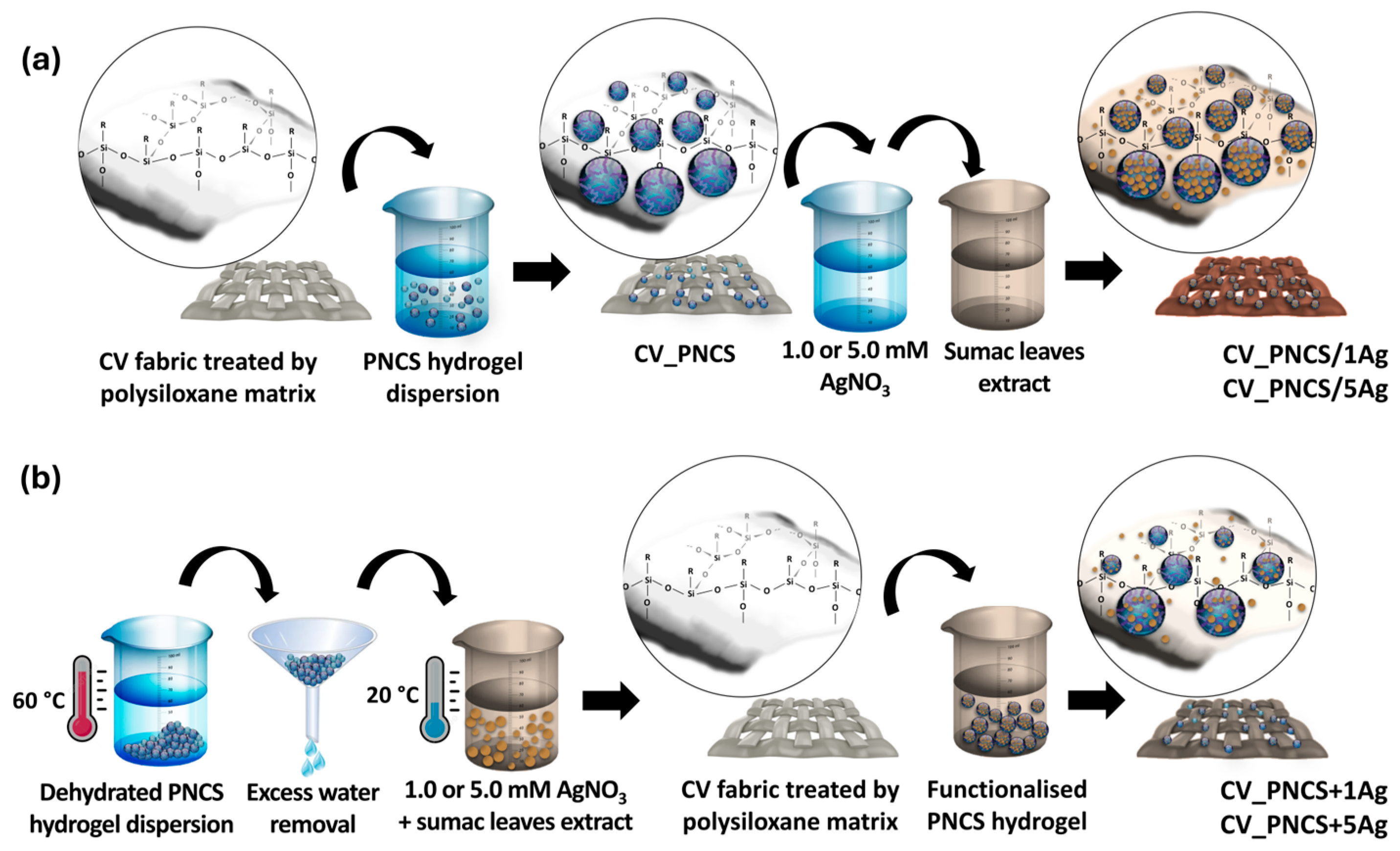
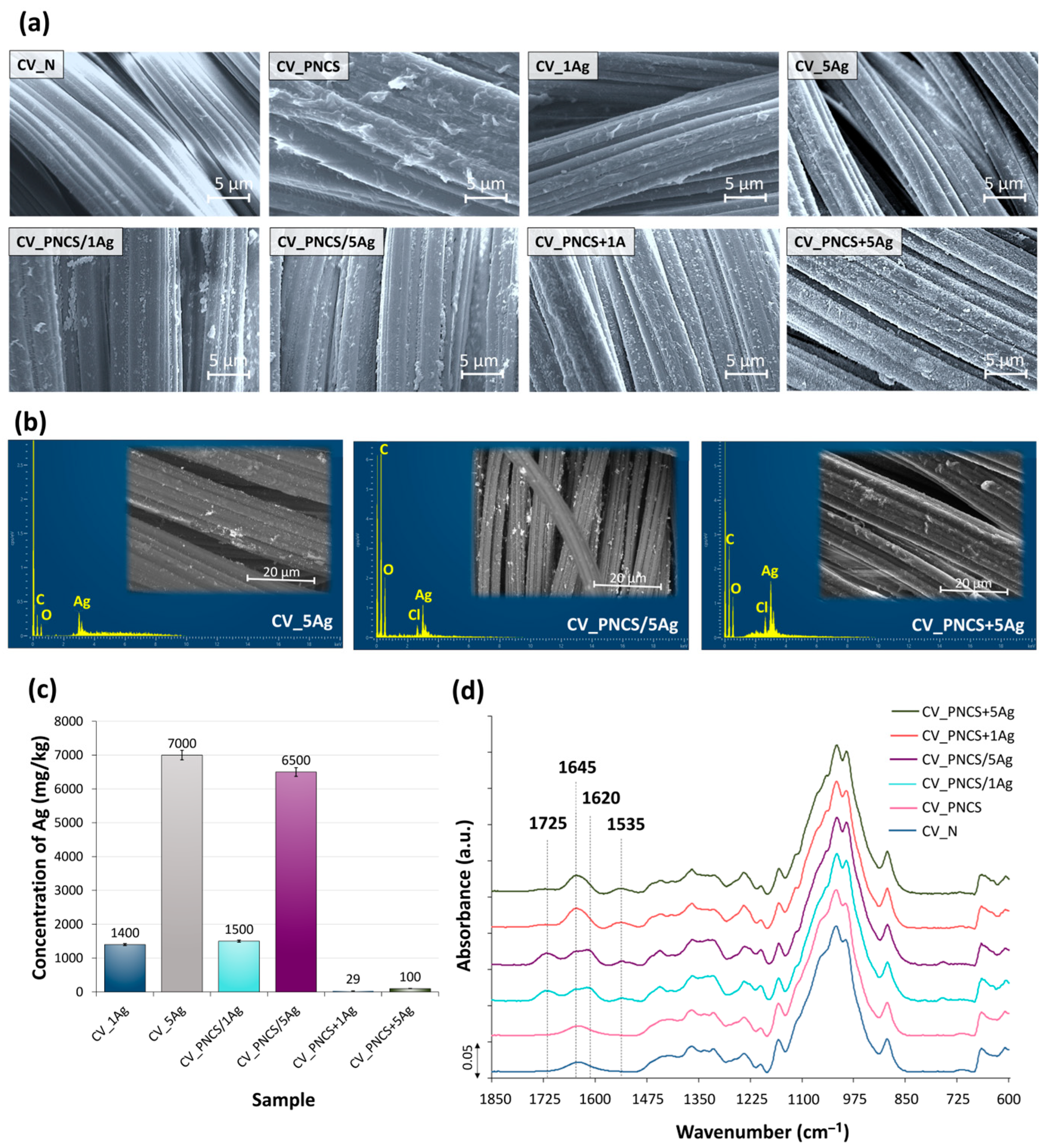
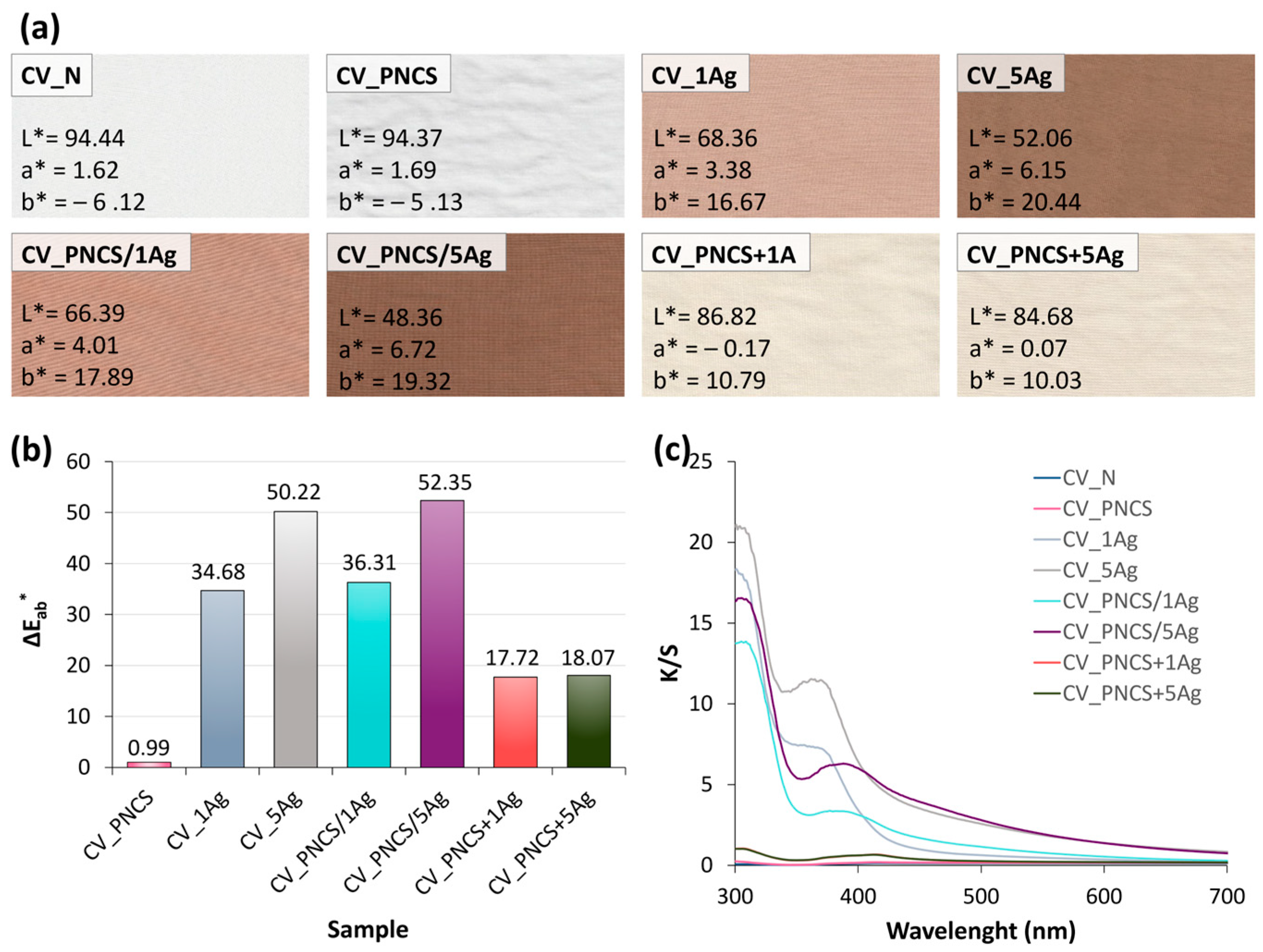
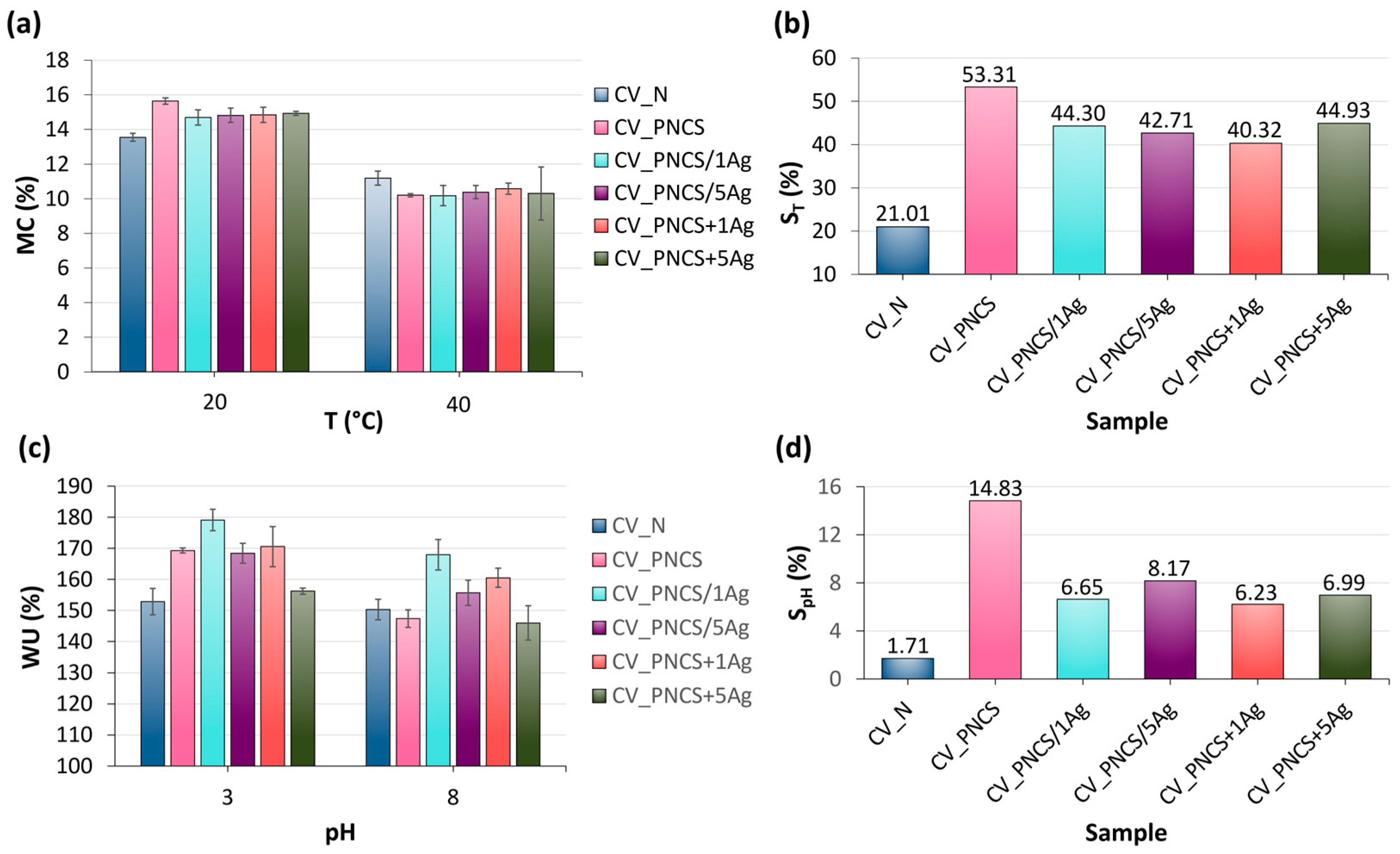
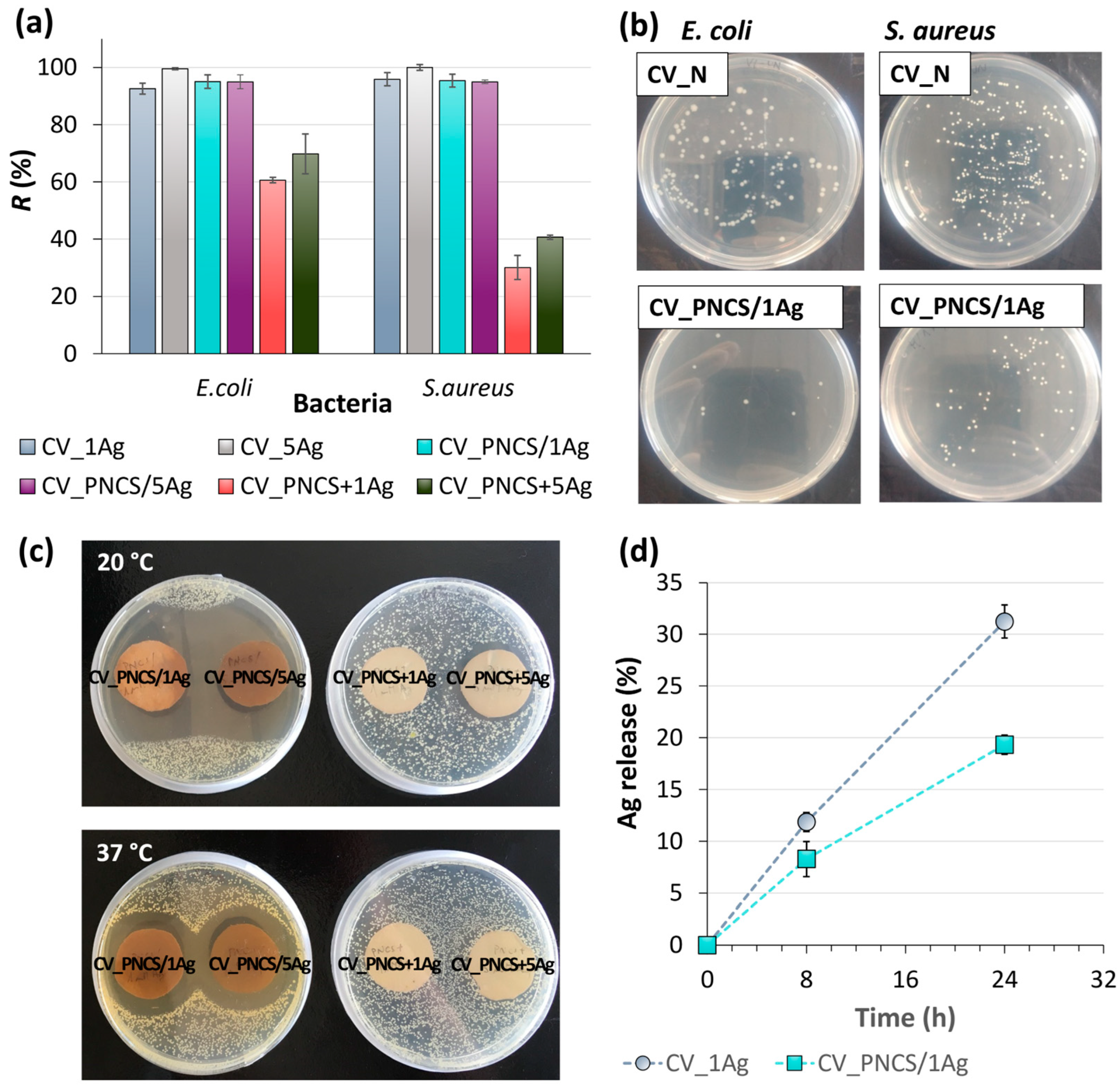

| Sample Code | Application Process | Details |
|---|---|---|
| CV_N | / | Unfinished |
| CV_xAg | In situ | The application of the polysiloxane matrix with the subsequent in situ synthesis of Ag NPs using the AgNO3 solution (x stands for the concentration of the AgNO3; i.e., x = 1.0 or 5.0 mM) |
| CV_PNCS | Pad-dry | The application of polysiloxane and PNCS hydrogel |
| CV_PNCS/xAg | Pad-dry + in situ | The application of the polysiloxane matrix, and PNCS hydrogel, and the in situ synthesis of Ag NPs using the AgNO3 solution (x stands for the concentration of the AgNO3; i.e., x = 1.0 or 5.0 mM) |
| CV_PNCS + xAg | Pad-dry | The application of the polysiloxane matrix and pre-functionalised PNCS hydrogel with Ag NPs synthesised using AgNO3 (x stands for the concentration of the AgNO3; i.e., x = 1.0 or 5.0 mM) |
| Sample | UVB Blocking (%) | UVA Blocking (%) | UPF | Protection Category 1 |
|---|---|---|---|---|
| CV_N | 57.75 | 62.54 | 2.43 | I |
| CV_PNCS | 53.92 | 60.44 | 2.25 | I |
| CV_1Ag | 98.45 | 97.47 | 58.49 | E |
| CV_5Ag | 98.33 | 97.91 | 57.16 | E |
| CV_PNCS/1Ag | 98.76 | 98.29 | 76.46 | E |
| CV_PNCS/5Ag | 98.68 | 98.49 | 73.39 | E |
| CV_PNCS + 1Ag | 86.22 | 80.99 | 6.83 | I |
| CV_PNCS + 5Ag | 87.30 | 84.14 | 7.54 | I |
Disclaimer/Publisher’s Note: The statements, opinions and data contained in all publications are solely those of the individual author(s) and contributor(s) and not of MDPI and/or the editor(s). MDPI and/or the editor(s) disclaim responsibility for any injury to people or property resulting from any ideas, methods, instructions or products referred to in the content. |
© 2024 by the authors. Licensee MDPI, Basel, Switzerland. This article is an open access article distributed under the terms and conditions of the Creative Commons Attribution (CC BY) license (https://creativecommons.org/licenses/by/4.0/).
Share and Cite
Glažar, D.; Štular, D.; Jerman, I.; Simončič, B.; Tomšič, B. Embedment of Biosynthesised Silver Nanoparticles in PolyNIPAAm/Chitosan Hydrogel for Development of Proactive Smart Textiles. Nanomaterials 2025, 15, 10. https://doi.org/10.3390/nano15010010
Glažar D, Štular D, Jerman I, Simončič B, Tomšič B. Embedment of Biosynthesised Silver Nanoparticles in PolyNIPAAm/Chitosan Hydrogel for Development of Proactive Smart Textiles. Nanomaterials. 2025; 15(1):10. https://doi.org/10.3390/nano15010010
Chicago/Turabian StyleGlažar, Dominika, Danaja Štular, Ivan Jerman, Barbara Simončič, and Brigita Tomšič. 2025. "Embedment of Biosynthesised Silver Nanoparticles in PolyNIPAAm/Chitosan Hydrogel for Development of Proactive Smart Textiles" Nanomaterials 15, no. 1: 10. https://doi.org/10.3390/nano15010010
APA StyleGlažar, D., Štular, D., Jerman, I., Simončič, B., & Tomšič, B. (2025). Embedment of Biosynthesised Silver Nanoparticles in PolyNIPAAm/Chitosan Hydrogel for Development of Proactive Smart Textiles. Nanomaterials, 15(1), 10. https://doi.org/10.3390/nano15010010









